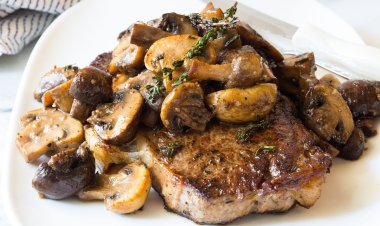Top 20 Tips for Succeeding at Food Blogging
Top 20 Tips for Succeeding at Food Blogging

Running a food blog may seem like a breeze, but running a truly successful one is an entirely different story. It’s not just about having a knack for food; it’s about mastering the tried-and-true techniques that guarantee top-notch content, technical finesse, and effective marketing strategies.
In today’s competition for readers, food bloggers must go the extra mile to ensure they attract and retain a devoted audience. Moreover, while there are common themes and patterns, there is no definitive answer to what that extra mile is. There are a bunch of tips for food bloggers on the internet, and all approach this topic from their own perspective.
For your convenience, this article gathers 20 food blogging tips that are likely to create the largest impact on your food blog’s success. You will surely benefit from these tips, whether you’re a beginner embarking on your blogging journey or seeking to enhance your existing website.
If you are an absolute beginner, we suggest you read our guide on becoming a food blogger first to ensure you do not skip any essential steps when launching your blog.
1. Improve your writing skills
The most crucial food blogging tip for any type of blog is to have good writing skills. Even though you don’t need to be Shakespeare to run a food blog, it does demand clear and engaging writing. This is the key to attracting and retaining an enthusiastic readership. Here are some recommended tips to enhance your writing skills:
- Use concise language that is free of jargon. Keep your writing straightforward and easily understandable to make it accessible to a wide audience.
- Incorporate storytelling techniques into your writing. Sharing personal anecdotes and narratives adds depth and captivates readers, creating a connection that keeps them coming back for more.
- Avoid overwhelming your readers with walls of text. Break up your content into shorter paragraphs and utilize headings and bullet points to make it visually appealing and easier to digest.
- Always proofread and edit your texts thoroughly to ensure a professional and polished final product. Consider utilizing grammar tools that can assist you in catching errors and enhancing your writing.
- Read and analyze different writing styles that inspire you. Take note of what makes those styles compelling and incorporate those elements into your own writing.
- Remember that practice makes perfect. The more you write, the better you’ll become at crafting engaging content for your food blog.
You can also consider looking at various guides for food writing or online courses that can help you improve your skills quickly.
2. Experiment with new recipes
You can have classic recipes on your website, but it’s also important to provide your readers with new recipes from time to time. This will help keep your content fresh and interesting while improving your skill set as a chef. You can get inspiration for new recipes by reading other food blogs, attending cooking classes, or reading cookbooks.
If you’re posting about classic dishes, consider putting your own spin on them. Fusion dishes tend to stand out from the crowd because they inspire and encourage your readers to be creative with their cooking.
Even if you have an experimental dish that goes wrong, it can still be great content. Posting about what went wrong and what you changed on your second attempt can be a great way to connect with your audience.
3. Create recipe indexes
In the vibrant world of food blogging, your recipes are the stars of the show. To provide the best experience to your readers, it is crucial to display them in an organized, appealing, and easy-to-understand manner. However, as your collection grows, it becomes challenging to edit and organize your recipes. That’s why it is important to invest time into recipe organization early on to prevent it from turning into an unmanageable mess as time goes by.
A great way to do that is to create recipe indexes, which are essentially a digital catalog of your recipes categorized by various criteria such as cuisine type, ingredient, occasion, or dietary restrictions. This organizational tool enhances the user experience by making it easier for your audience to find exactly what they’re looking for. It also significantly boosts your SEO, helping search engines better understand and index your content.
There are various plugins you can use to create your recipe indexes; however, it is a somewhat technical process. If you are not tech-savvy or new to the food blogging world, WP Recipe Maker is the tool for you. It requires zero technical knowledge to use and is designed to provide a smooth user experience. With WP Recipe Maker, you can easily create detailed recipes, publish them easily, and organize them by various categories in your blog, such as cuisine, ingredients, dietary preferences, and so on.
4. Master food photography
Honing your food photography skills is one of the most essential food blogging tips for truly excelling and captivating your readers. Mouth-watering pictures of the dishes you make work wonders when it comes to capturing the attention of your readers and increasing the chance of your recipes being shared on other platforms.
Here are some tips to guide you in taking great pictures of your dishes:
- Understand your camera: Whether it’s the latest DSLR or the camera on your smartphone, getting to know its features is your first step. Explore various settings and understand which conditions they’re best suited for. If a DSLR is your choice, delve into the world of lenses; a macro lens, for example, can beautifully capture the textures and details of your food. Learn the ins and outs of your camera, whether that’s a brand-new DSLR or your trusty iPhone (and if you’re buying or bought a DSLR, think about the lenses that will make your food shots look their best).
- Photography tools you need to master:
- Foam boards: A simple yet effective tool for bouncing light and adding brightness to your shots.
- Lighting: Not all food photography takes place in ideal natural light. Invest in a good-quality light source to mimic natural light.
- Tripod: Stability is key to crisp, clear food photos, especially in low-light conditions or when capturing the steam rising from a hot dish.
- Editing software: Post-processing can transform a good photo into a great one. Whether it’s Adobe Lightroom, Photoshop, or a simpler app, choose software that suits your needs and skill level.
- Diffuser/reflector: These are invaluable for managing natural light, ensuring your dish is illuminated just right, without harsh shadows.
The most important tools in your hands are practice and patience. Experiment with different styles, angles, and compositions to find what best represents your culinary vision. if you seek additional guidance, consider participating in online courses, workshops, or following tutorials tailored to food photography.
5. Learn food styling
While captivating photography captures your audience’s attention, it’s the art of food styling that makes them linger and crave. Investing a little extra time in styling and presenting your dishes in a visually appealing manner is well worth the effort.
Here are some key strategies to elevate your food styling game:
- Understand color and contrast: One of the foundational elements of food styling is the use of color. Think about adding a pop of color with fresh herbs, edible flowers, or a drizzle of brightly colored sauce. Contrast not only applies to colors but textures and shapes as well, adding depth and interest to your dishes.
- Composition and balance: How you arrange the elements on the plate can tell a story. Consider the rule of thirds to make your composition more dynamic: Play with the placement of your main ingredient, garnishes, and even negative space to create balance and harmony in your dish.
- The right props: Selecting the right plate, cutlery, and background can complement the food’s colors and textures, enhancing its overall appeal. Consider the theme and mood you want to convey and choose props that align with it.
- Keep it real: While you want your dishes to look their best, maintaining a sense of authenticity is crucial. Avoid over-styling to the point where the dish looks unnatural or inedible.
In addition to increasing the appeal of tour recipes, one of the goals of food styling is to evoke emotions and create a connection with your audience.
6. Keep up to date on what’s trending
Another important tip for succeeding as a food blogger is staying relevant to the trends. There are various approaches to staying updated on food trends. Reading food industry publications, attending real-world food events, and joining online communities like food blogger entrepreneurs are excellent ways to stay informed on what’s going on. To provide relevant and engaging content, consider incorporating trending ingredients or putting your own spin on viral recipes.
However, it’s also important to tailor your trend research to your target audience. For instance, if your blog caters to a youth-focused demographic, exploring viral TikTok food trends would be more relevant and captivating than looking at what Michelin-starred restaurants are offering. Tools like Google Trends are a great way to learn more about what people are searching for in the world of food and beyond. Keep an eye on the social media platforms and publications that speak to your target audience to ensure you don’t miss out on a trend. Be sure to use the right food-related hashtags to discover new food content ideas before everyone else does and share your own.
7. Create cooking videos
For food bloggers, cooking videos have become a game-changer, offering tremendous potential to boost engagement and expand your reach.
Creating captivating cooking videos is easier than you might think. You can achieve a polished and professional final product by carefully planning your content, following lighting and sound best practices, and editing with precision.
Once your video is ready, embed it into the relevant recipe on your food blog. With WP Recipe Maker, incorporating cooking videos into your online recipes is straightforward. This plugin allows you to append videos to your chosen recipe templates and position them at any location within the recipe card.If you want to build your food blogging brand accross multiple digital channels, be sure to also share your latest cooking videos across your social media platforms. For example, consider starting your own YouTube cooking channel to showcase your culinary skills and build awareness of your food blog.
8. Update your blog regularly
Successful food blogs don’t have one-time visitors; they have loyal, repeat visitors. This can only happen to you if you post regularly. In addition to maintaining reader interest, regularly updating your website will help improve search engine ranking.
The frequency of your updates depends on your specific needs and capabilities, but aiming for one or two posts per week is a reasonable goal. Over time, you’ll accumulate a catalog of posts your audience can dive into, enhancing their engagement with your blog.
To stay on top of your content creation, it’s important to establish a regular schedule. Set aside dedicated time, such as an hour each morning, to create and refine your posts. By adhering to a consistent content creation routine, you’ll ensure a steady stream of new content for your readers to enjoy.
9. Engage with your readers
Establishing and maintaining a meaningful connection with your blog’s readers is key to fostering a loyal audience. Here are some tips on how you can actively connect with your audience:
- Respond to them: Make it a priority to respond to blog comments. A simple acknowledgment can go a long way in making your readers feel valued. This personal touch encourages an ongoing conversation and fosters a welcoming community atmosphere.
- Ask for feedback: Invite your readers to share their thoughts on your content through polls, surveys, or direct questions at the end of your posts. This not only gives you valuable insights into their preferences but also makes them feel involved in the content creation process.
- Use social media: Extend the conversation to social media platforms where you can share behind-the-scenes glimpses, quick updates, and more casual interactions. Use platforms like Instagram, Facebook, and TikTok to share stories, ask questions, and engage in real-time with your followers.
- Host interactive events: Use interactive elements such as quizzes, contests, or live cooking sessions on your website to boost engagement.
10. Build your mailing list
A mailing list is a long-term investment in your food blogging career. It’s an asset that grows and matures with your blog, providing a stable foundation for your online presence. Whether you’re launching a new cookbook, hosting a webinar, or collaborating with brands, your mailing list serves as a ready audience that’s already interested in what you have to offer. Therefore, one of the most critical food blogging tips is to pay attention to this aspect and build a mailing list as soon as possible.
Building a mailing list involves collecting email addresses from your readers with their permission, allowing you to communicate directly with them. Unlike social media platforms, where your content’s reach can be limited by changing algorithms, your mailing list ensures your messages land directly in your subscribers’ inboxes.
One of the most popular ways to collect email addresses is to start a newsletter or a subscription plan to unlock your most popular posts. You can also consider running competitions or giveaways where your readers can join by adding their email addresses.
Building a mailing list might seem daunting initially, but it’s a powerful tool for nurturing a deeper relationship with your readers. It allows you to send personalized updates, exclusive recipes, or sneak peeks into upcoming projects, making your audience feel special and valued.
11. Create engaging newsletters
Your visitors may not always think to check your website, but an enticing email can remind them to do so for new recipes and food tips. An email newsletter is a good way to promote new content and stay in regular contact with your readers.
In addition to promoting your content, this food blogging tip is especially important in terms of adding to the value offer of your blog. The context of your newsletter could range from exclusive recipes not found on your blog to personal stories from your culinary journey, behind-the-scenes peeks, or early access to special events and promotions. All of which provide a way for you to connect with your newsletter subscribers.
Your emails should include things of value, including exclusive content, personal updates, and special promotions. However, it can be more difficult to manage these newsletters as your follower list grows. To fully manage your email marketing campaigns, it’s best to use an email marketing platform such as Mailchimp or ActiveCampaign. With these tools, you can design visually appealing emails, segment your audience for targeted campaigns, automate sending schedules, and analyze the performance of your emails easily, which will save you time and effort. Also, make sure you include a newsletter subscription box on your homepage!
12. Personal connection
Your website is more than just a collection of recipes – it’s an opportunity for readers to get to know you on a personal level. In the crowded world of food blogging, what truly sets you apart is the uniqueness of your personal story.
Infusing your content with personal anecdotes, experiences, and reflections turns each recipe or blog post into a window into your life. This approach transforms your blog from a simple how-to guide into a narrative that resonates on a deeper emotional level.
The essence of creating a personal connection lies in being authentic, real, and human, inviting readers into your world with open arms. You can take inspiration from bloggers like Sue from MyKoreanKitchen, who not only shares Korean recipes on her blog but also talks about her heritage and personal experiences with these recipes.
13. Look for networking opportunities
It is equally important to step outside your digital kitchen to mingle with fellow creators, culinary experts, and industry influencers while creating top-notch content for your food blog. Networking will expand your reach, enhance your knowledge, and forge partnerships that can elevate your blog to new heights.
Here are some tips on how to grow your network:
- Look for guest posts: Guest posts refer to your posts that get published on other food blogs or culinary websites. This not only showcases your expertise to a new audience but also helps in building valuable backlinks to your blog.
- Attend food blogging conferences: Conferences dedicated to food blogging are excellent for learning industry trends, discovering new tools, and networking with fellow bloggers.
- Participate in local food events: Engage with your local food scene by attending or participating in food festivals, markets, and competitions. This can connect you with local chefs, restaurateurs, and food enthusiasts, enriching your blog with local flavor.
- Social media groups: Join online forums and social media groups related to food blogging. These platforms allow sharing experiences, asking for advice, and collaborating on projects with peers worldwide.
14. Optimize for SEO
Your website can’t be successful if no one can find it. Ensuring your site’s SEO credentials are up to scratch is essential for increasing visibility and attracting visitors.
Some handy ways to improve your SEO include researching and using relevant keywords, optimizing your images, and posting high-quality content.
The WP Recipe Maker plugin also has built-in SEO features that can push your site up the search engine rankings, including speed optimization, metadata handling, mobile friendliness, and an SEO-friendly data structure. Thus, you can increase your blog’s visibility while quickly creating and editing your recipes.
15. Work on your social media presence
Social media is a fantastic tool for promoting your food blog and reaching a larger audience. It starts with making sure you’re using the right platform since you don’t need to be on all of them! If your content targets mostly millennials, you’ll want to be on Instagram, while TikTok could be a good choice for you if you target Gen Z foodies.
Once you decide which platforms will serve you better, don’t just use your accounts as a megaphone. The best practice is to engage with other food bloggers, influencers, and your audience. This way, over time, you can build up a community.
If you are unsure what type of content works well, you can get inspired by following the top food bloggers on Instagram, including Ree Drummond and Tieghan Gerard. It’s also recommended to use social media scheduling tools such as Buffer and Hootsuite, which can help to keep your social media content on track.
16. Offer different content formats
Diversifying your content formats can significantly enhance your food blog’s appeal, catering to varied reader preferences and learning styles. Offering a variety of content formats not only engages your current audience but also attracts new visitors, providing multiple entry points to discover your culinary world.
Here are some alternative contact formats you can consider providing:
- Infographics can simplify complex recipes or techniques into eye-catching, shareable visuals, making them a hit on social media platforms.
- Downloadable PDFs of your recipes add a layer of convenience, allowing readers to easily print your recipes and bring your creations into their kitchens without the need for digital devices.
- Interactive content, such as quizzes or interactive ingredient maps, invites your audience to engage directly with your blog, turning passive reading into an active, enjoyable experience.
- Podcasts or audio segments open up another avenue for engagement, allowing your audience to listen to culinary stories, interviews, and discussions on the go.
Considering that your food blog’s highlight will be its recipes, it is especially important for your blog to support various recipe formats as well. That’s why the recipe management plugin WP Recipe Maker was designed to support online, downloadable, and video recipe formats.
17. Monetize your blog
If you’ve built a successful blog, you’ll be in a strong position to monetize your website and build an income as a food blogger. Monetizing your blog also means your brand will expand into a new market and reach a wider range of audiences. Monetizing your food blog requires a strategic approach, focusing on methods that align with your content and audience. Here are some tips on how to monetize your food blog:
- Sponsored content: Collaborating with brands to create content that promotes their products can be a lucrative revenue stream. This could range from sponsored blog posts to social media shoutouts.
- Affiliate marketing: This involves recommending products or services through affiliate links within your content. When a reader clicks on these links and makes a purchase, you earn a commission.
- Advertising: Displaying ads on your site is one of the most straightforward ways to earn revenue. Platforms like Google AdSense can automate the process of placing relevant ads for your audience.
- Memberships and subscriptions: Offering premium content or exclusive perks to paid subscribers can create a steady income stream. This could include detailed guides, video tutorials, or members-only recipes.
The key to success with any of these methods is choosing partnerships, ads, or content that align with your blog’s niche and values, ensuring authenticity, and maintaining trust with your audience.
18. Be transparent
Trust is at the heart of your relationship with your readers. Your readers’ faith in your authenticity and honesty not only bolsters your credibility but also enhances your blog’s reputation in the long run.
First, it’s critical to be open about the products you recommend. When you suggest an ingredient, kitchen tool, or culinary book, ensure your recommendations are grounded in genuine appreciation and firsthand experience.
Another critical tip for bloggers is clearly labeling sponsored posts, affiliate links, and partnerships. This maintains transparency and ensures your audience can make informed decisions about the products and services you endorse.
Also, sharing your successes and failures adds a human touch to your blog. Not every recipe attempt ends in triumph, and not every product test lives up to expectations. By being candid about these experiences, you invite your readers into your real culinary journey, one that’s punctuated with learning and growth.
19. Have a clear copyright policy
Not all food blogging tips focus on the user experience. This one specifically focuses on you, the blogger. As a food blogger, your recipes, photographs, and articles are not just the heart of your blog; they’re a manifestation of your creativity and hard work. To safeguard these assets, establishing a clear copyright and content reuse policy is essential.
Now, when you create and publish a blog, it is immediately protected by copyright because you used your unique skills, judgment, and effort to create it. However, there is a catch when it comes to the food blogs: Recipes you share do not fall under this protection.
There’s a logical explanation for this. Copyright laws protect the assets you produce using your creativity, expertise, and unique approach to the topic. Recipes, however, are considered a list of ingredients and objective instructions and thereby have no creative elements to be protected.
To make your way around it, you can try to add a personal touch to the recipes you share. An extra spice, a different way of cooking, or an unexpected way of combining ingredients will make the recipe unique enough to make it yours.
A copyright policy will protect the recipes you create and allow you to control the extent to which others can use your content. This includes specifying whether your work can be shared, if attribution is required (and in what form), and the extent to which your content can be modified or used commercially. You can create your copyright policy and place it on the footer section of your blog as “Terms and Conditions” for your readers to easily access.
20. Track your metrics
Understanding the impact of your food blog requires more than just posting content and hoping for the best. Actively tracking your blog’s performance through various metrics allows you to gauge its success and identify areas for improvement.
This involves analyzing quantitative data, such as the number of visitors each post received, and qualitative data, such as feedback from your visitors.
Some key metrics to focus on are page views, social media engagement, and newsletter subscribers/open rate. Stay away from vanity metrics, which tend to focus on surface-level indicators that may not directly contribute to the overall goals of the blog, such as driving website traffic, generating conversions, or fostering meaningful interactions with the audience. An example of a vanity metric could be the number of likes you get on a social media post, as it doesn’t necessarily translate to traffic to your blog.
Use tools such as Google Analytics to have a clear view of your blog’s performance; it’ll help you to make data-driven decisions and improve your website.
A recipe for success: Final thoughts on food blogging
There are many ways to capture success as a food blogger. Each tip, from mastering your writing skills to tracking your metrics, adds something else to your blog. But let’s not forget, amid all these strategies and techniques, the heart and soul of your blog: being genuine and authentic.
Imagine your blog as your kitchen table, where you invite readers from around the world to sit, chat, and share a meal. The dishes you serve –your posts, photos, and stories –are all infused with your unique essence. This authenticity, this you-ness, is what turns a simple visit to your blog into a memorable meal that keeps guests coming back.
To get the most from your website, consider using WP Recipe Maker, a WordPress plugin that allows food bloggers to create visually appealing, user-friendly recipes for their websites. WP Recipe Maker comes with various extra tools to support your food blog, depending on your audience size, customization, or e-commerce needs.
To get started, choose the right WP Recipe Maker plan for your needs, put our tips into practice, and create a stunning food blog that will captivate your readers’ hearts and stomachs!













